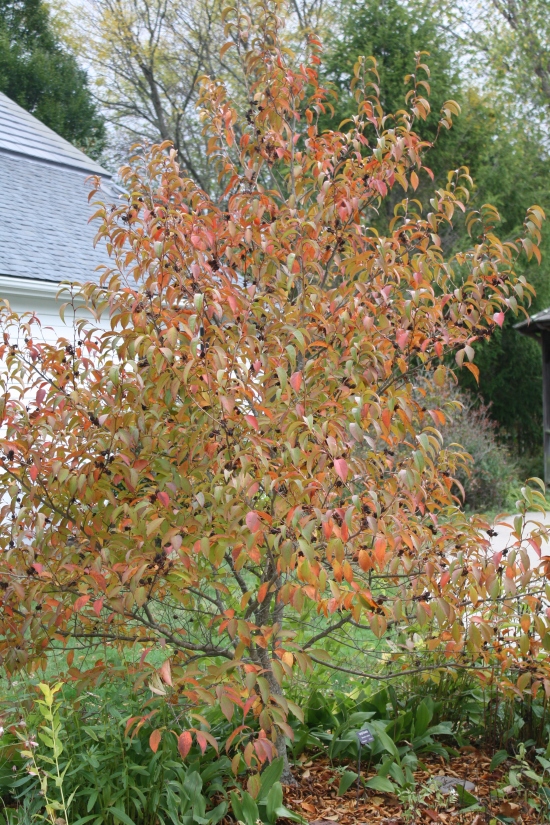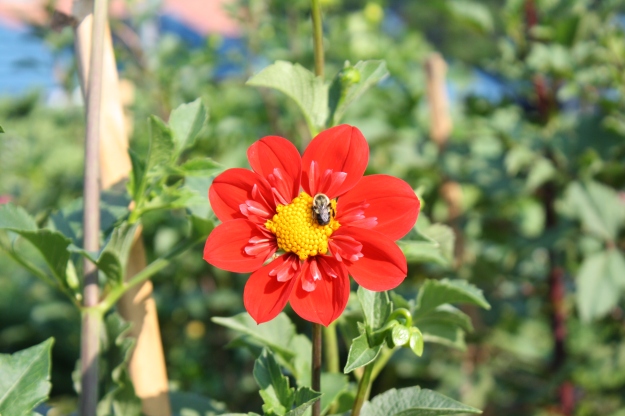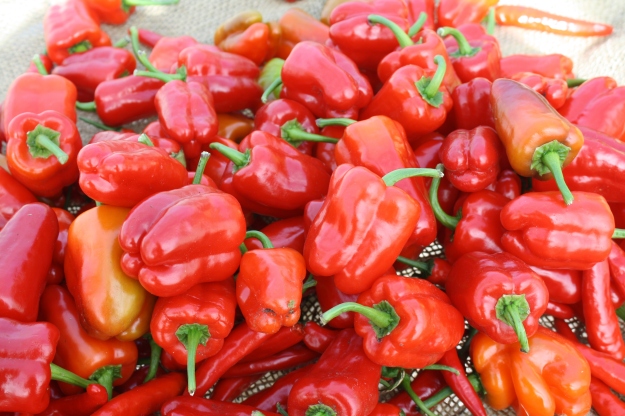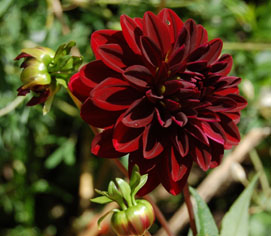
In the spring I referred to peonies as the “Queen of Flowers”. Perhaps I should have said the Queen of “Early Summer Flowers”. Because now as summer begins to wane, (it’s not over yet!) there is another queen: the Dahlia.

Dahlias are strikingly beautiful flowers which come in a huge variety—thousands of cultivars— of colors and sizes. They are native to Mexico but have been known and loved in Europe since the early 1800s. Garden dahlia flowers range in size from 2-3 inches across to as large as 12 inches across. The plants themselves can be from just 12 inches high, great for low borders or even containers, to as tall as 48 inches. Colors range from white to pink, yellow, red, purple and everything in between. (But not blue, green, or black, as far as I know). The flowers come in many forms : “cactus”, “pompom”, “anemone”, “single”, and more. This link has nice clear pictures of the different flower forms:
http://www.everydayjourney.net/lightbox/index.php?category=gallery/Flora/Dahlias

I received a gift last fall for the Botanical Gardens from Linda J. — a big muddy pile of unlabeled dahlia tubers. After rinsing and letting them dry, I wrapped them in newspaper, packed them into a waxed box, put the box in the cellar, and forgot all about them. In the spring during a cellar clean- up day, one of The Boys found the box and brought it up. It was a little late — the tubers were sprouting, a few had shriveled up, but nothing was rotten. I decided to plant everything that looked even remotely viable. We staked them all, not knowing if they were dwarf or tall, large- or small-flowered. (Staking can be critical: Large dahlia flowers are heavy, and the stems are hollow and brittle.)

So, it’s September, and here they come! We have a large (6-7 inch) pink and 2 large white, a medium sized pink, and lots of buds. I’m hoping for all kinds of colors! None of the Dahlias are over 36 inches or so, which means that next year they go in a more visible spot. Right now they’re in the garden just west of the greenhouse, tucked between the hedge and the ‘Heatwave’ Agastache.

Dahlias can be grown as annuals, but I treat them as tender perennials. When a hard frost kills back all the foliage, the tubers will be dug up, LABELED, and packed away for next year. In the spring they can be divided and each section of tuber with an “eye” will produce a new plant. In a good year there will be 3-5 new tubers on each plant — plenty to share!

Like the other Queen of Flowers, the Peony, Dahlias are not hard to grow. They prefer full sun and well drained soil. I planted them like potatoes, putting the tubers in the bottom of the hole, covering with only an inch or two of soil, and gradually backfilling the hole as the stem grew until it was filled in. A low nitrogen (vegetable garden ) fertilizer and a little bonemeal is enough. They don’t need heavy watering and tolerate heat and dry weather, although watering once a week when they begin blooming is helpful. Dahlias make great cut flowers as well as being a bright spot in the garden through September. Here’s hoping we have a whole rainbow of colors to enjoy this month.

 Hard frost came to my home garden in the wee hours of Monday morning. Here at the top of Kingston Hill, the Botanical Garden had none to speak of, but the plants are looking pretty tired. Lack of rain, deer, woodchucks, and rabbits took their toll this year! Wide swaths of Phlox and Chelone were eaten to little nubs, then eaten again. Hostas disappeared early on. Echinacea has become a wildlife delicacy. Annuals were lunch as soon as they were set out. There are a few bright spots: Japanese Anemones (eaten and recovered), Dahlias (near the road= not eaten), Toad Lilies (also eaten and recovered), Ornamental Peppers (untouched!), Callicarpa, and of course, beautiful fall foliage.
Hard frost came to my home garden in the wee hours of Monday morning. Here at the top of Kingston Hill, the Botanical Garden had none to speak of, but the plants are looking pretty tired. Lack of rain, deer, woodchucks, and rabbits took their toll this year! Wide swaths of Phlox and Chelone were eaten to little nubs, then eaten again. Hostas disappeared early on. Echinacea has become a wildlife delicacy. Annuals were lunch as soon as they were set out. There are a few bright spots: Japanese Anemones (eaten and recovered), Dahlias (near the road= not eaten), Toad Lilies (also eaten and recovered), Ornamental Peppers (untouched!), Callicarpa, and of course, beautiful fall foliage.














 The Dahlia is a genus of plants that has great diversity, exhibiting some flowers that are small and compact, whereas others are large and the leaves are open relative to one another. This diversity comes from Dahlias being octoploids where most plants are diploids in their chromosomal structure. The Dahlias also don’t emit any fragrance, so they rely on their brightly colored petals to attract pollinators. Even though they’re native to Mexico, they do well here and are always a pleasure to look at.
The Dahlia is a genus of plants that has great diversity, exhibiting some flowers that are small and compact, whereas others are large and the leaves are open relative to one another. This diversity comes from Dahlias being octoploids where most plants are diploids in their chromosomal structure. The Dahlias also don’t emit any fragrance, so they rely on their brightly colored petals to attract pollinators. Even though they’re native to Mexico, they do well here and are always a pleasure to look at. 
 Phlox paniculata ‘David’ is a white cultivar of Phlox that gives a bright contrast and jumps out immediately. Even in a dark night with only moonlight it is pronounced among the other plants. It has a soft texture and just seems very calm to me, not too gaudy or in your face.
Phlox paniculata ‘David’ is a white cultivar of Phlox that gives a bright contrast and jumps out immediately. Even in a dark night with only moonlight it is pronounced among the other plants. It has a soft texture and just seems very calm to me, not too gaudy or in your face.  Pink Powder Puff (Calliandra emarginata) is just funny to look at, I think. Native to Mexico, it has these really goofy looking flowers that resemble exploding fireworks. It makes an awesome picture, and they flower year round in the greenhouse too, which is pretty awesome if you ask me.
Pink Powder Puff (Calliandra emarginata) is just funny to look at, I think. Native to Mexico, it has these really goofy looking flowers that resemble exploding fireworks. It makes an awesome picture, and they flower year round in the greenhouse too, which is pretty awesome if you ask me. The compost pile, to me, resembles the cyclical nature of plants – and life in general really. Even though things die, they can always be re-purposed into something new, giving nutrients and new life to the plants that come after them. I guess it all comes down to how in-depth and metaphysically you think when you look at a pile of dirt – but there is a lot that compost contributes to the garden and the plants of the future.
The compost pile, to me, resembles the cyclical nature of plants – and life in general really. Even though things die, they can always be re-purposed into something new, giving nutrients and new life to the plants that come after them. I guess it all comes down to how in-depth and metaphysically you think when you look at a pile of dirt – but there is a lot that compost contributes to the garden and the plants of the future.






























